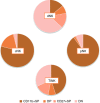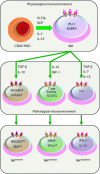Subsets of human natural killer cells and their regulatory effects
- PMID: 24303897
- PMCID: PMC3956422
- DOI: 10.1111/imm.12224
Subsets of human natural killer cells and their regulatory effects
Abstract
Human natural killer (NK) cells have distinct functions as NK(tolerant) , NK(cytotoxic) and NK(regulatory) cells and can be divided into different subsets based on the relative expression of the surface markers CD27 and CD11b. CD27⁺ NK cells, which are abundant cytokine producers, are numerically in the minority in human peripheral blood but constitute the large population of NK cells in cord blood, spleen, tonsil and decidua tissues. Recent data suggest that these NK cells may have immunoregulatory properties under certain conditions. In this review, we will focus on these new NK cell subsets and discuss how regulatory NK cells may serve as rheostats or sentinels in controlling inflammation and maintaining immune homeostasis in various organs.
Keywords: cell differentiation; human natural killer cells.
© 2013 John Wiley & Sons Ltd.
Figures




References
-
- Flodstrom-Tullberg M, Bryceson YT, Shi FD, Hoglund P, Ljunggren HG. Natural killer cells in human autoimmunity. Curr Opin Immunol. 2009;21:634–40. - PubMed
-
- Narni-Mancinelli E, Ugolini S, Vivier E. Tuning the threshold of natural killer cell responses. Curr Opin Immunol. 2013;25:53–8. - PubMed
-
- Hayakawa Y, Smyth MJ. CD27 dissects mature NK cells into two subsets with distinct responsiveness and migratory capacity. J Immunol. 2006;176:1517–24. - PubMed
-
- Vossen MT, Matmati M, Hertoghs KM, et al. CD27 defines phenotypically and functionally different human NK cell subsets. J Immunol. 2008;180:3739–45. - PubMed
Publication types
MeSH terms
Substances
LinkOut - more resources
Full Text Sources
Other Literature Sources
Research Materials

